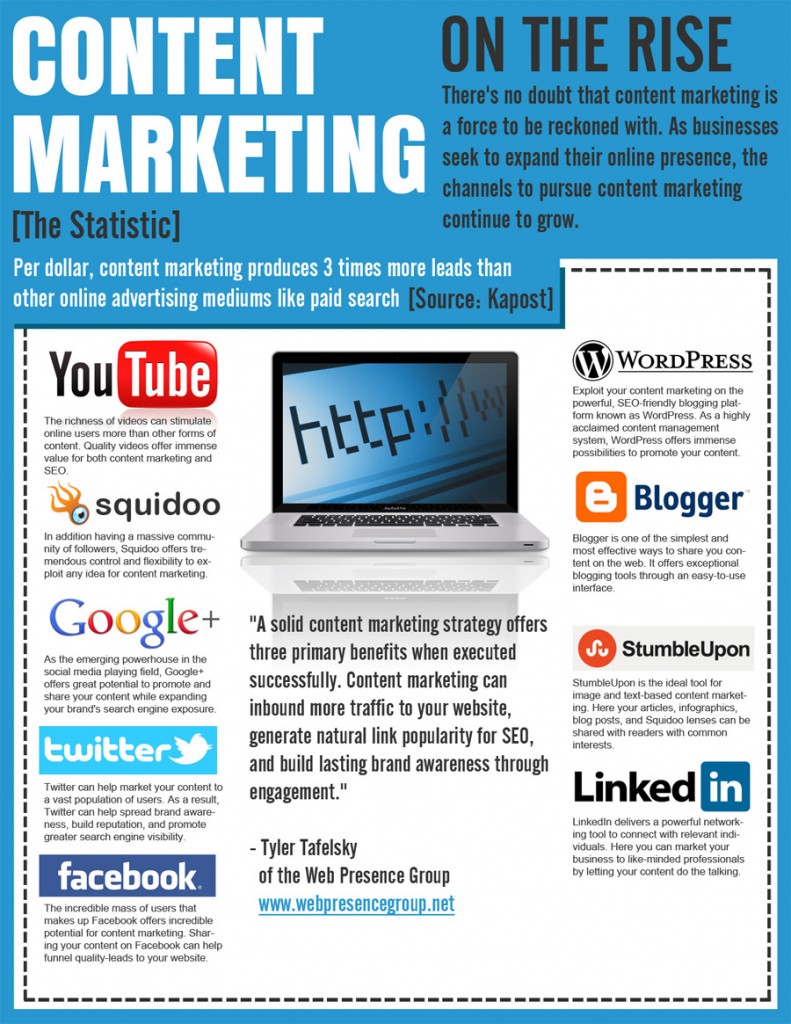Have you ever read an article/blog post with continuous text, but somehow got lost or bored that you had to abandon the post? When a particular topic involves a lot of numbers, it can be very boring and a reader can easily get lost no matter how you structure your content. As an alternative, brands use infographics for content marketing to bring the boring data to life, graphically.
Infographics in simple terms is the graphical representation of voluminous data in a way that is easier for a reader to understand. It requires a bit of analytical skills as well as graphic design to come up with infographics that capture the attention of the reader.
You have probably just heard a lot of buzz about infographics lately. The fact is that infographics have been in existence for quite a long time. They were especially used by Newspaper outlet to make it easier for their readers to understand an otherwise complex or voluminous information.
With content marketing becoming popular in the past couple of years, infographics has become one of the avenues that brands are using to promote themselves and share useful information with their followers and customers.
Particularly in Kenya, we are very poor when it comes to data and information. Internet users are hungry for this information that they desperately need you as the leader brand in your niche to provide.
Infographics can really help someone arrive at a critical decision when buying a product. Like any other content marketing strategy, it can create interest and, in turn, generate more leads for products and services that your company or organization provides.
Why Use Infographics for Content Marketing
It is almost imperative that you incorporate infographics in your content marketing strategy. Infographics generally swallow up data and presents it beautifully for your readers to understand. Below are some of the reasons why you are totally failing if you do not use infographics for content marketing.
#1 The Visual Appeal
As stated earlier, infographics are generally visually appealing and internet users tend to respond to infographics better that other forms of content. It takes less time for them to interpret the data or information relayed and therefore in turn reduces the conversion time for the customer. Research has shown that about 40% of internet users prefer graphical information rather than textual information.
#2 You can Never be too Serious
All work and no play, will definitely make your brand a dull one. Infographics are generally used to bring a spark to a rather boring piece of information. The colors used and the design of the information on your infographics will really bring the information to life.
#3 Simplicity Works
Yes, you have a lot of very interesting data. However, your data may be very confusing and complicated for the reader and the message might never get home. Infographics are used to make data that was once complex to become easier for the reader to understand. In this, you will be achieving your objectives of distributing this information in the first place.
#5 Boost Search Engine Optimization Efforts
Content marketing plays a major role when it comes to search engine optimization. With the recent change in algorithms by Google and other search engines, content marketing has fast gained ground as one strategy that matters to a great extent. SEO is one of the best internet marketing strategies and therefore it is important that you always seek to improve the presence of your websites on all major search engines.
How to go about Designing Infographics
Infographics are normally time-consuming and that is why very many brands shy away even if they have the relevant data.
The first step when it comes to infographics is the collection of relevant data and analyzing it. The space is normally limited and therefore you might not get the chance to share all the data that you have. Instead of this, choose the most interesting parts that would clearly make sense to the user.
Secondly, take the data you have and rank them accordingly. The most important aspects should be readily available for the user. This is what should be on the top of your infographics. Ensure you round off your large numbers to make the infographics visually appealing.
The next step will be sending this information to your graphic designers to come up with the design aspect of the infographics through the data provided. The design should be as simple as it can be for the consumers to easily understand.
Ensure you distill the information from the most important data on top, down to other less important data.
The Bottom Line with Infographics
Infographics are a great addition to your campaigns and they will easily set you apart from your other competitors. You can easily become the source of good information in your niche. Kenyans are a very busy lot and therefore prefer to source for information in places that it will take them less time to get the right information.
Infographics greatly reduce the amount of time that another person will go through the same piece of information in text form. The readers getting this information would more likely understand the information on infographics compared to the textual forms.
Marketing the infographics is much easier, especially on social media platforms. People on social media are also more likely to share infographics and they can much easily go viral. Viral content usually boost a brand and is normally the breakthrough, especially for small businesses.
Infographics can be used in industries that have so much data, such as the banking industry or the insurance industry. The other day I went to shop for an insurance policy and by the time I went through 3 agents, I was more confused than before. If you are not in a particular industry, it can be very confusing to understand data thrown at you randomly.
A good idea can be getting this information in infographics and presenting it in a way that the man on the street can understand. It makes it easier for someone to arrive at conclusion and possibly convert.
Whether it is online or offline, you can use infographics for content marketing in a way that can greatly benefit your brand.









